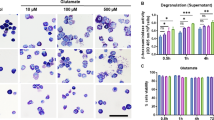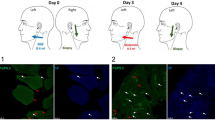Abstract
Trypsin and mast cell tryptase cleave proteinase-activated receptor 2 and, by unknown mechanisms, induce widespread inflammation. We found that a large proportion of primary spinal afferent neurons, which express proteinase-activated receptor 2, also contain the proinflammatory neuropeptides calcitonin gene-related peptide and substance P. Trypsin and tryptase directly signal to neurons to stimulate release of these neuropeptides, which mediate inflammatory edema induced by agonists of proteinase-activated receptor 2. This new mechanism of protease-induced neurogenic inflammation may contribute to the proinflammatory effects of mast cells in human disease. Thus, tryptase inhibitors and antagonists of proteinase-activated receptor 2 may be useful anti-inflammatory agents.
This is a preview of subscription content, access via your institution
Access options
Subscribe to this journal
Receive 12 print issues and online access
$209.00 per year
only $17.42 per issue
Buy this article
- Purchase on Springer Link
- Instant access to full article PDF
Prices may be subject to local taxes which are calculated during checkout







Similar content being viewed by others
References
Déry, O., Corvera, C.U., Steinhoff, M. & Bunnett, N.W. Proteinase-activated receptors: novel mechanisms of signaling by serine proteases . Am. J. Physiol. 274, C1429– 1452 (1998).
Vu, T.K., Hung, D.T., Wheaton, V.I. & Coughlin, S.R. Molecular cloning of a functional thrombin receptor reveals a novel proteolytic mechanism of receptor activation. Cell 64, 1057–1068 (1991).
Ishihara, H. et al. Protease-activated receptor 3 is a second thrombin receptor in humans. Nature 386, 502– 506 (1997).
Kahn, M.L. et al. A dual thrombin receptor system for platelet activation. Nature 394, 690–694 ( 1998).
Nystedt, S., Emilsson, K., Wahlestedt, C. & Sundelin, J. Molecular cloning of a potential proteinase activated receptor. Proc. Natl. Acad. Sci. U S A 91, 9208– 9212 (1994).
Molino, M. et al. Interactions of mast cell tryptase with thrombin receptors and PAR-2. J. Biol. Chem. 272, 4043– 4049 (1997).
Saifeddine, M., Al-Ani, B., Cheng, C., Wang, L. & Hollenberg, M. Rat proteinase-activated receptor-2 (PAR-2): cDNA sequence and activity of receptor-derived peptides and in gastric and vascular tissue . Br. J. Pharmacol. 118, 521– 530 (1996).
Emilsson, K. et al. Vascular effects of proteinase-activated receptor 2 agonist peptide. J. Vasc. Res. 34, 267– 272 (1997).
Kawabata, A., Kuroda, R., Minami, T., Kataoka, K. & Taneda, M. Increased vascular permeability by a specific agonist of protease-activated receptor-2 in rat hindpaw. Br. J. Pharmacol. 125, 419–422 ( 1998).
Vergnolle, N., Hollenberg, M.D., Sharkey, K.A. & Wallace, J.L. Characterization of the inflammatory response to proteinase-activated receptor-2 (PAR2)-activating peptides in the rat paw. Br. J. Pharmacol. 127, 1083–1090 (1999).
Hou, L. et al. Immunolocalization of protease-activated receptor-2 in skin: receptor activation stimulates interleukin-8 secretion by keratinocytes in vitro. Immunology 94, 356–362 ( 1998).
He, S. & Walls, A.F. Human mast cell tryptase: a stimulus of microvascular leakage and mast cell activation. Eur. J. Pharmacol. 328, 89–97 ( 1997).
He, S., Peng, Q. & Walls, A.F. Potent induction of a neutrophil and eosinophil-rich infiltrate in vivo by human mast cell tryptase: selective enhancement of eosinophil recruitment by histamine. J. Immunol. 159, 6216– 6225 (1997).
Compton, S.J., Cairns, J.A., Holgate, S.T. & Walls, A.F. The role of mast cell tryptase in regulating endothelial cell proliferation, cytokine release, and adhesion molecule expression: tryptase induces expression of mRNA for IL-1 beta and IL-8 and stimulates the selective release of IL-8 from human umbilical vein endothelial cells. J. Immunol. 161, 1939–1946 (1998).
Brain, S.D. & Williams, T.J. Substance P regulates the vasodilator activity of calcitonin gene-related peptide. Nature 335, 73–75 (1988).
Newbold, P. & Brain, S.D. The modulation of inflammatory edema by calcitonin gene-related peptide. Br. J. Pharmacol. 108, 705–710 (1993).
Holzer, P. Neurogenic vasodilatation and plasma leakage in the skin. Gen. Pharmacol. 30, 5–11 ( 1998).
Brain, S.D., Williams, W.J., Tippins, J.R., Morris, H.R. & MacIntyre, I. Calcitonin gene-related peptide is a potent vasodilator. Nature 313, 54– 56 (1985).
Hughes, S.R. & Brain, S.D. A calcitonin gene-related peptide (CGRP) antagonist (CGRP8-37) inhibits microvascular responses induced by CGRP and capsaicin in skin. Br. J. Pharmacol. 104, 738–742 (1991).
Bowden, J.J. et al. Direct observation of substance P-induced internalization of neurokinin 1 (NK1) receptors at sites of inflammation. Proc. Natl. Acad. Sci. U S A 91, 8964–8968 (1994).
Baluk, P., Bertrand, C., Geppetti, P., McDonald, D.M. & Nadel, J.A. NK1 receptors mediate leukocyte adhesion in neurogenic inflammation in the rat trachea. Am. J. Physiol. 268, L263–L269 (1995).
Stead, R.H. et al. Intestinal mucosal mast cells in normal and nematode-infected rat intestines are in intimate contact with peptidergic nerves. Proc. Natl. Acad. Sci. U S A 84, 2975– 2979 (1987).
Naukkarinen, A., Harvima, I.T., Aalto, M.L. & Horsmanheimo, M. Mast cell tryptase and chymase are potential regulators of neurogenic inflammation in psoriatic skin. Int. J. Dermatol. 33, 361–366 (1994).
Metcalfe, D.D., Baram, D. & Mekori, Y.A. Mast cells. Physiol. Rev. 77, 1033–1079 (1997).
Vergnolle, N. et al. Proteinase-activated receptor 2 (PAR2)-activating peptides: identification of a receptor distinct from PAR2 that regulates intestinal transport. Proc. Natl. Acad. Sci. U S A 95, 7766–7771 (1998).
Corvera, C.U. et al. Mast cell tryptase regulates rat colonic myocytes through proteinase-activated receptor 2. J. Clin. Invest. 100 , 1383–1393 (1997).
Corvera, C.U. et al. Thrombin and mast cell tryptase regulate guinea-pig myenteric neurons through proteinase-activated receptors-1 and -2. J. Physiol. (Lond.) 517, 741–756 ( 1999).
Tam, E.K. & Caughey, G.H. Degradation of airway neuropeptides by human lung tryptase. Am. J. Respir. Cell Mol. Biol. 3, 27–32 (1990).
Kawabata, A., Saifeddine, M., Al-Ani, B., Leblond, L. & Hollenberg, M.D. Evaluation of proteinase-activated receptor-1 (PAR1) agonists and antagonists using a cultured cell receptor desensitization assay: activation of PAR2 by PAR1-targeted ligands. J. Pharmacol. Exp. Ther. 288, 358– 370 (1999).
Oku, R. et al. Calcitonin gene-related peptide promotes mechanical nociception by potentiating release of substance P from the spinal dorsal horn in rats . Brain Res. 403, 350–354 (1987).
Le Greves, P., Nyberg, F., Terenius, L. & Hökfelt, T. Calcitonin gene-related peptide is a potent inhibitor of substance P degradation. Eur. J. Pharmacol. 115, 309–311 (1985).
Biella, G., Panara, C., Pecile, A. & Sotgiu, M.L. Facilitatory role of calcitonin gene-related peptide (CGRP) on excitation induced by substance P (SP) and noxious stimuli in rat spinal dorsal horn neurons. An iontophoretic study in vivo. Brain Res. 559, 352– 356 (1991).
Reinshagen, M. et al. Action of sensory neurons in an experimental at colitis model of injury and repair. Am. J. Physiol. 270, G79–86 (1996).
Reinshagen, M. et al. Calcitonin gene-related peptide mediates the protective effect of sensory nerves in a model of colonic injury. J. Pharmacol. Exp. Ther. 286, 657–661 ( 1998).
Koshikawa, N. et al. Expression of trypsin in vascular endothelial cells. FEBS Lett. 409, 442–448 (1997).
Cocks, T.M. et al. A protective role for protease-activated receptors in the airways. Nature 398, 156– 160 (1999).
Wiegand, U., Corbach, S., Minn, A., Kang, J. & Muller-Hill, B. Cloning of the cDNA encoding human brain trypsinogen and characterization of its product. Gene 136, 167–175 (1993).
Nystedt, S., Ramakrishnan, V. & Sundelin, J. The proteinase-activated receptor 2 is induced by inflammatory mediators in human endothelial cells. Comparison with the thrombin receptor . J. Biol. Chem. 271, 14910– 14915 (1996).
Kong, W. et al. Luminal trypsin may regulate enterocytes through proteinase-activated receptor 2. Proc. Natl. Acad. Sci. U S A 94, 8884–8889 (1997).
Ennes, H.S., Young, S.H., Raybould, H.E. & Mayer, E.A. Intercellular communication between dorsal root ganglion cells and colonic smooth muscle cells in vitro. Neuroreport 8, 733–737 (1997).
Geppetti, P. et al. Distribution of calcitonin gene-related peptide-like immunoreactivity in various rat tissues: correlation with substance P and other tachykinins and sensitivity to capsaicin. Regul. Pept. 23, 289–298 (1988).
Renzi, D. et al. in Trends in Cluster Headache (eds. Sicuteri, F., Vecchiet, L. & Fanciullacci, M.) 125–134 (Elsevier, Amsterdam, 1987).
Wallace, J.L., McCafferty, D.M. & Sharkey, K.A. Lack of beneficial effect of a tachykinin receptor antagonist in experimental colitis. Regul. Pept. 73 , 95–101 (1998).
Gardiner, S.M. et al. Human alpha-calcitonin gene-related peptide (CGRP) (8–37), but not -(28–37), inhibits carotid vasodilator effects of human alpha-CGRP in vivo. Eur. J. Pharmacol. 199, 375– 378 (1991).
McCafferty, D.M., Wallace, J.L. & Sharkey, K.A. Effects of chemical sympathectomy and sensory nerve ablation on experimental colitis in the rat. Am. J. Physiol. 272, G272–280 (1997).
Acknowledgements
Supported by the National Institutes of Health, Crohn's and Colitis Foundation of America, the Medical Research Council of Canada, North Atlantic Treaty Organization (NATO), and St. Anna Hospital, Ferrara, Italy. We thank V. Ossovskaya, E. Grady, and A. Steinhoff for valuable advice.
Author information
Authors and Affiliations
Corresponding author
Rights and permissions
About this article
Cite this article
Steinhoff, M., Vergnolle, N., Young, S. et al. Agonists of proteinase-activated receptor 2 induce inflammation by a neurogenic mechanism. Nat Med 6, 151–158 (2000). https://doi.org/10.1038/72247
Received:
Accepted:
Issue Date:
DOI: https://doi.org/10.1038/72247
This article is cited by
-
Esophageal mast cells may be associated with the perception of symptoms in patients with eosinophilic esophagitis
Esophagus (2023)
-
Diversification of PAR signaling through receptor crosstalk
Cellular & Molecular Biology Letters (2022)
-
IL-31, itch and hematological malignancies
Clinical and Molecular Allergy (2021)
-
Molecular Dambusters: What Is Behind Hyperpermeability in Bradykinin-Mediated Angioedema?
Clinical Reviews in Allergy & Immunology (2021)
-
Neurokinin 1 Receptor Antagonists for Pruritus
Drugs (2021)



